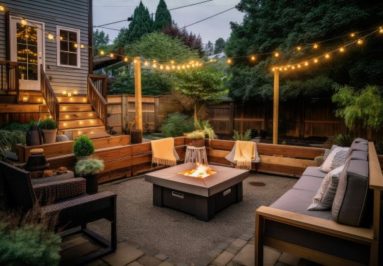What is Structure-Borne Noise?
Structure borne noise or structure borne sound is defined as noise that occurs from the impact of an object hitting a surface, like heavy footsteps falling against a floor. The impact causes both sides of the inflicted surface to vibrate and generate sound waves. For example, if your upstairs neighbor drops a book onto the floor, the collision will vibrate from the floor up into their space as well as down the other side, through the ceiling of your space.
The key to reducing structure-borne noise is weakening the vibrations created from the noise source. While it is impossible to eliminate all structure-borne noise, there are a number of ways to greatly reduce it.
Types of Structure Borne Sound
The main type of structure-borne sound that tends to be a nuisance is footfall from above. Some of us are all too familiar with footfall noise, especially if you live in a multi-level apartment building or in a multi-level house. Sometimes it can sound like the you upstairs neighbors are stomping around as hard as they can, but they’re probably walking around normally and the floor assembly wasn’t built effectively to mitigate structure borne noise.

Some other types of structure borne sound can be slamming doors or home improvement work such as hammering or drilling. Some airborne noise can actually become structure borne as the sound waves travel through the air. For example, the way sound such as a voice or music moves through a wall starts out as airborne sound, but once it hits the wall it travels through the wall cavity as structure borne and airborne noise. The structure borne potion will travel through the drywall, move into the studs, and then come out the other side.
Other structure borne noise can be a result of:
- Rigidly mounted rooftop AC Units
- Garbage going down a trash chute
- Noisy Pipes and HVAC
Ways To Reduce Structure Borne Noise
If your structure-borne sound problem is extreme, or if it is coming from inside the building itself via pipes and other mechanical noise sources, it may require a an intricate fix. The Wall Blokker and Wall Blokker Pro are ECA-based Mass Loaded Vinyl, engineered to mitigate a wide range of frequencies for superior noise reduction. These sound reduction materials are designed for installation behind a finished wall during construction or between an existing wall and a new layer of drywall during renovations.
If you aren’t able to remove your existing drywall to install MLV, consider building a second wall in front of your existing wall. Installing MLV on existing drywall with an extra layer will only get you an extra 2-3 STC points, while another wall will improve your STC by about 11 points.
Simply add metal furring strips with an inch of air gap in front of your existing wall, attach Wall Blokker to the furring strips and then add a new layer of drywall to finish it. You may lose a few inches of space in your room, but you’ll gain some peace and quiet.
If your structure-borne sound problem is coming from above, a similar product exists for your floor. The Floor Blokker or another 5mm thick sound underlayment is the best solution for combating footfall noise form the floor above. Similar to Wall Blokker and Wall Blokker PRO, Floor Blokker works to decouple the finish floor from the subfloor, which helps to block the path of sound.
Mechanically generated structure borne noise can be mitigated using Pipe Lagging. Pipe lagging combines a layer of mass loaded vinyl with a layer of 3 pcf fiberglass, and when wrapped around pipes or AC vents, it helps to mitigate the noise they may cause.
Reducing Airborne Sound that Comes with Structure Borne Sound
The first thing you’ll want to do is check for sound leaks in your walls. Even the smallest cracks allow structure-borne noise to enter your space more easily, so be meticulous in your search. Windows and doors tend to be the most susceptible areas, but any gaps will lend to the noise problem. After you have located these weak spots, fill them in with acoustical sealant to reinforce the structure and make it more difficult for sound to penetrate.

If you live near a construction site, there’s probably a lot of structure borne sound occurring there, but you’ll be hearing it as airborne sound as it comes in through your windows. Consider a window treatment such as soundproof curtains to help block this sound. Soundproof curtains are made using Mass Loaded Vinyl, and can block anywhere between 60%-80% of noise.
Structure Borne Noise Explained
Common structure borne noises include:
- Footfall
- Slamming Doors
- Hammering/Drilling
Structure borne noise is typically mitigate using resilient materials that act as “shock absorbers”. This includes mass loaded vinyl products used between studs and drywall, or drywall and drywall. It can also include flooring underlayments made of MLV or crumbled rubber that help to mitigate footfall noise from above.





